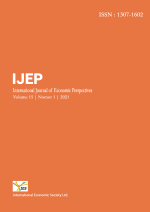E-commerce revolution
Contemporary challenges of legal regulation
Keywords:
communication, contemporary, e-commerce, legal regulation, revolutionAbstract
The rapid growth of e-commerce has created the need for vibrant and effective regulatory mechanisms, which would strengthen the legal infrastructure that is crucial to the success of e-commerce in India. It has always been the allegation that the weak cyber security laws in India and the absence of a proper e-commerce regulatory framework is the reason for what Indian people as well as the e-commerce industries face so many challenges in enjoying a consumer-friendly and business-confidant e-commerce environment in India. Legal community in India is required to the necessary expertise to guide entrepreneurs, consumers and even courts in a manner that the fast emerging business module is enabled to adhere to existing legislations normally applicable to business transactions in conventional modules. Simultaneously, it should ensure that the advantages of technology are availed of unhindered by judicious evolution of law through learned interpretation of court still a consensus emerges that a specialized law to govern and regulate certain aspects of e‐commerce is imperative and an exclusive necessity.
References
Ahmad, F. (2001). Electronic Commerce: An Indian Perspective. International Journal of Law and Information Technology, 9(2), 133-170.
Bernstein, S. E., Amirkhani, E., Werb, D., & MacPherson, D. (2020). The regulation project: Tools for engaging the public in the legal regulation of drugs. International Journal of Drug Policy, 86, 102949. https://doi.org/10.1016/j.drugpo.2020.102949
Bizzini, A., & Greub, G. (2010). Matrix-assisted laser desorption ionization time-of-flight mass spectrometry, a revolution in clinical microbial identification. Clinical Microbiology and infection, 16(11), 1614-1619. https://doi.org/10.1111/j.1469-0691.2010.03311.x
Corbitt, B. J., Thanasankit, T., & Yi, H. (2003). Trust and e-commerce: a study of consumer perceptions. Electronic commerce research and applications, 2(3), 203-215. https://doi.org/10.1016/S1567-4223(03)00024-3
Dasih, I. G. A. R. P., Triguna, I. B. G. Y., & Winaja, I. W. (2019). Intercultural communication based on ideology, theology and sociology. International Journal of Linguistics, Literature and Culture, 5(5), 29-35. https://doi.org/10.21744/ijllc.v5n5.738
Halinen, A., & Törnroos, J. Å. (2005). Using case methods in the study of contemporary business networks. Journal of business research, 58(9), 1285-1297. https://doi.org/10.1016/j.jbusres.2004.02.001
Hoen, M. M., & Pink, F. E. (2002). Contemporary endodontic retreatments: an analysis based on clinical treatment findings. Journal of endodontics, 28(12), 834-836. https://doi.org/10.1097/00004770-200212000-00010
Kshetri, N. (2007). Barriers to e-commerce and competitive business models in developing countries: A case study. Electronic commerce research and applications, 6(4), 443-452. https://doi.org/10.1016/j.elerap.2007.02.004
Loewenstein, W. R. (1979). Junctional intercellular communication and the control of growth. Biochimica et Biophysica Acta (BBA)-Reviews on Cancer, 560(1), 1-65. https://doi.org/10.1016/0304-419X(79)90002-7
Lukman, .-., Abdulhak, I., & Wahyudin, D. (2016). Learning model development to improve students’ oral communication skill: (a research and development study on english as a foreign language (EFL) subject in all junior high schools in north of lombok, west nusa tenggara province). International Journal of Linguistics, Literature and Culture, 2(2), 147-166. Retrieved from https://sloap.org/journals/index.php/ijllc/article/view/103
Malhotra, D. (2016). Globalization and E-Commerce in India: Issues and Challenges. Available at SSRN 2759762.
Meltzoff, A. N. (1999). Origins of theory of mind, cognition and communication. Journal of communication disorders, 32(4), 251-269. https://doi.org/10.1016/S0021-9924(99)00009-X
Miller, G. A. (2003). The cognitive revolution: a historical perspective. Trends in cognitive sciences, 7(3), 141-144. https://doi.org/10.1016/S1364-6613(03)00029-9
Mingaleva, Z., & Mirskikh, I. (2013). The problems of legal regulation and protection of intellectual property. Procedia-Social and Behavioral Sciences, 81, 329-333. https://doi.org/10.1016/j.sbspro.2013.06.437
Mitra, A. (2013). E-commerce in India-A Review. International journal of marketing, financial services & management research, 2(2), 126-132.
Vladimir, Z. (1996). Electronic commerce: structures and issues. International journal of electronic commerce, 1(1), 3-23.
Published
How to Cite
Issue
Section
Copyright (c) 2021 Ashwini Vinod Ingole

This work is licensed under a Creative Commons Attribution 4.0 International License.
Allows users to: distribute and copy the article; create extracts, abstracts, and other revised versions, adaptations or derivative works of or from an article (such as a translation); include in a collective work (such as an anthology); and text or data mine the article. These uses are permitted even for commercial purposes, provided the user: gives appropriate credit to the author(s) (with a link to the formal publication through the relevant URL ID); includes a link to the license; indicates if changes were made; and does not represent the author(s) as endorsing the adaptation of the article or modify the article in such a way as to damage the authors' honor or reputation. CC BY







